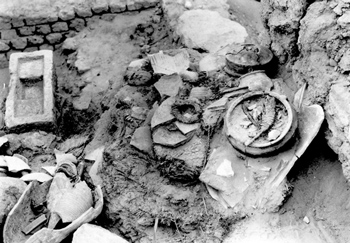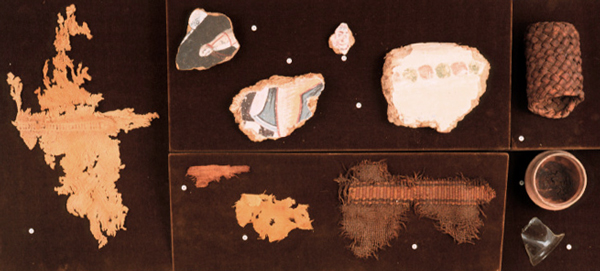
 |
 |
 |
 |
 |
 |
 |
 |
 |
Case 7: Finds from House 124
 |
|
House
124, room B
Showing objects as found in room B Kelsey Museum Archives, 5.1582 |
Textile Finds and Other Assemblages from House 124
In the earlier phase of use marked by the buildings of layer B, only one textile was found, but the discovery of cloth-making tools, a spindle whorl and loom weight, suggest a context in which plain cloths were made in the home. Finds from house 124 on the surface layer A, including a spindle whorl and a total of seventy-four plain or minimally decorated, competently woven textiles, suggest that cloth-making activities may have continued during the later phase of use.
For each of the five rooms of house 124, a fairly distinctive assemblage can be reconstructed from excavation notes and photographs. The assemblages in room A, a large room, perhaps a courtyard, and adjacent rooms C and D contained few textiles, all plain and well worn. Other artifacts suggest multi-purpose rooms in which items were stored in various sorts of containers but where few items of value were kept.
In contrast, the assemblages in interior rooms B (see archival photo) and E (see artifacts in the case) included a wider variety of artifactual remains, such as the remains of food and serving dishes, more valuable pieces of jewelry and items associated with religious ritual, such as terracotta figurines and wall paintings. The cloth and other furnishings found in these rooms are of higher quality than those found elsewhere in the house.
It is possible that cloth-making and mending occurred here: textiles--some decorated with stripes, some mended--were found in greater numbers in these rooms along with unspun fibers and a spindle whorl. These interior rooms served multiple purposes as well: here, in comfortable private surroundings, meals were served and eaten, and prayers offered, perhaps in the company of sacred images.
